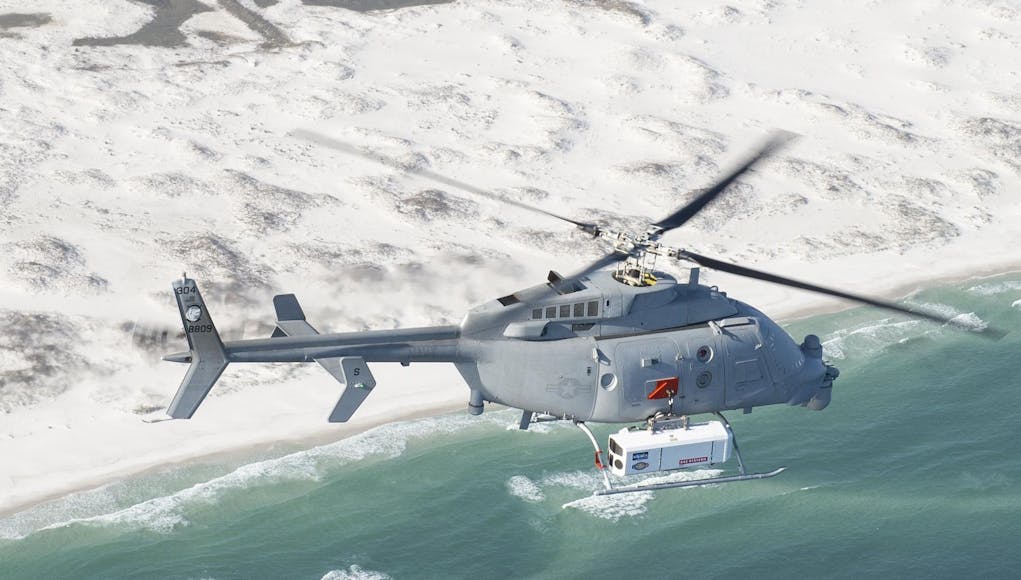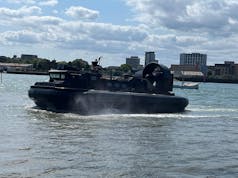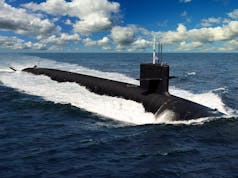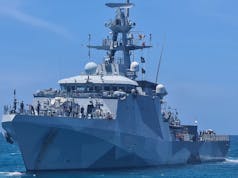The U.S. Navy recently demonstrated BAE Systems-developed mine countermeasure technology aboard an MQ-8C Fire Scout helicopter drone.
The U.S. Navy say that the objective of the demonstration was to gather performance data for both the MQ-8C Fire Scout and Single-system Multi-mission Airborne Mine Detection (SMAMD) System to inform future MCM integration efforts.
“The team successfully demonstrated that the prototype SMAMD System effectively operates as designed aboard the MQ-8C Fire Scout unmanned helicopter in relevant real world environments,” said Capt. Thomas Lansley, Fire Scout program director.
“This cutting-edge technology could really enhance Fire Scout’s capability going forward.”
The team conducted operations from the Naval Surface Warfare Center (NSWC) utilising drifting, tethered, and moored mines throughout beach zone to deep waters. They gathered data day and night, across all water depths and in mild to difficult weather conditions.
“The demonstration also proved the reliable and repeatable high performance of the MQ-8C Fire Scout. The air vehicle handled the dual podded system with ease, being the first MCM capability flown on the MQ-8C as well as the heaviest payload carried to date. Fire Scout successfully operated in restricted and unrestricted air space alongside other aircraft platforms.
The SMAMD System, developed by BAE Systems under a Future Naval Capability (FNC) Program sponsored by the Office of Naval Research (ONR), is an airborne optical sensor suite that, in a single pass, detects and localizes mines and obstacles on land and at sea. With a low false-alarm rate, SMAMD provides real-time detection sent via data link enabling warfighters to respond much quicker to threats than the current MCM technologies allow as post-mission analysis is required.”
You can read more on this here.














Looks ideal for keeping port approaches clear.
This is the loadout the Polish Arrowhead 140 (Type 31’s) are going with, they are practically cruisers with this firepower.
The 128 Sea Ceptor load is impressive, though you’d think they carry less and carry some longer range air-defence missiles instead. It depends whether the Polish frigate is intended to provide area air-defence or defend just itself. If the intent is just Baltic and littoral operations then area defence can be provided from shore.
There are sensible reasons why the RN has gone with the gun calibres that it has, no problem with those choices. Poles seem to have gone for existing punch over future smart shells under development.
Anti-ship missiles are good, but sticking them in canisters on deck always seems very Heath Robinson to me. Seems akin to sticking a gun magazine on deck. The best positioning seems to be the Zumwalt layout; though that added to the astronomical cost of the vessels, then next-best a farm of vertical launch tubes.
I’d also question the torpedoes. If they’re for submarines then for them to be effective a submarine captain would have to come well within the range of his own own torpedoes which out-range ship-launched torpedoes. Perhaps operating in the Baltic this is more of a possibility compared to the Atlantic?
They are light torpedoes and the helicopter will carry them as well, I think its more to give an option for hitting something under the surface. The Baltic is more of a knife fight ocean than the Atlantic. The MU90 also have a torpedo interception capability as well.
The helicopter carrying them makes sense, as per RN doctrine of engaging submarines outside of torpedo range using the helicopter. But I can see in the cramped waters of the Baltic, a ship borne capability could be useful.
Makes you wonder if the RN can have 4-6 of these for its T32 requirement and to compliment the post PIP T45s and T26s when they come into service? We don’t have to have the same weapons fit and may want a mk41 included but it’s good to see what can be done on this type of vessel alone. The powers that be in MoD surely can see this and do something likewise for the RN.
Sorry, the diagram mentions 4 Mk41s above already. Has CAMM/ CAMM-ER actually been integrated into the Mk41s as well as ExLS?
Yes
Looks ok. I don’t get why go to the cost and complexity of hot launched mk41 launchers when using a cold launch missile. Also would there be room for an 11m Rhib boat with the launchers going through the decks? Now all we need to see is a final price with all that kit added in to it. I’m guessing €550m minimum.
It’s odd looking at a ship with no VLS at the front.
Mk41 allows for more options. CAMM and CAMM-ER launch tubes can be fitted into a Mk41, so it will still be cold launched. CAMM is a radar agnostic system, I’m not sure something like SM2 is. It would make sense to have at least a few medium range SAMs like SM2 or Aster 30. Though the Thales NS50 will need replacing with something Like the NS100 for a bit more detection range.
Seems another good use for drones. Anything that can deal with mines and keeps servicemen well away from unnecessary danger gets my vote.
This is a great idea. These pods that can be added to the drone helicopter are a great solution and maybe there might be more flavours to come. Now an surface search and under water search would be a great addition to this.
I still wonder if the best shape for an unmanned helicopter is basically a manned helicopter. Will be interesting to see what will come along in the future when you take the squishy bit out of it.
Does anyone know if the RN looking at trialling adopting the MQ-8C Fire Scout at all?
Back in the times of legend in the late 80s doing Armilla Gulf Patrols (during the tanker wars) RN Lynx helos where flying with an optical mine detection system. It fitted in the aft equip bay and consisted of a downward looking camera with displays in the cabin.
The helo flew ahead of the ship and using filters and image processing you could see moored and free floating mines down to a considerable depth.
Once identified the ship could manouver away from the area.
Not 100% on the project name but I think it was Kingfisher.
It was one of numerous optional extras fitted to our Gulf Mod Lynx at the time. IR jammer, Chaff and flare launchers, secure radios, GPS, M3 Machine gun pods, Yellow Veil Jammer Pods, very low-level enabled sea skua
Wasnt Kingfisher! That was the EO turret that was added to Lynx and Seaking weapon carriers before they got the PID fitted on the nose.
Mine hunting camera was Demon Camera…
I like the MQ-8C, and the V-247, as unmanned pairs with manned helos on RN escorts; One with a Merlin or one with a Lynx gives that extra endurance and flexibility without the full cost of a manned aircraft.
This new MCM kit is just another example of its usefulness, although I’d personally be more interested in ISR, ASW and maybe light attack.